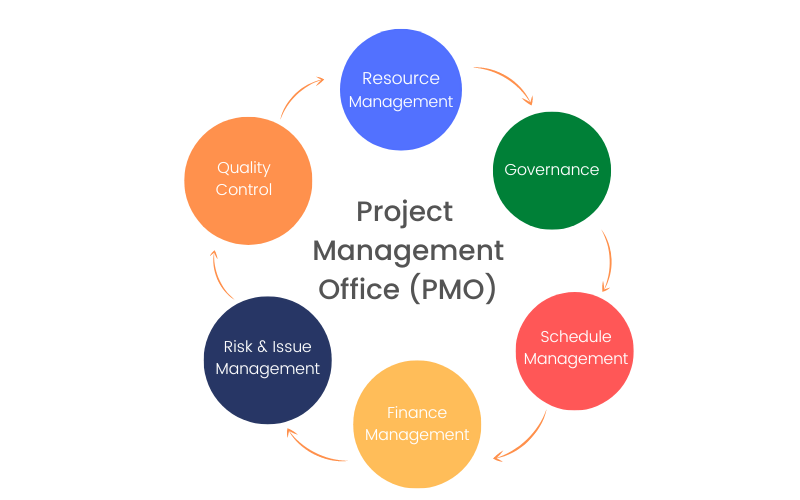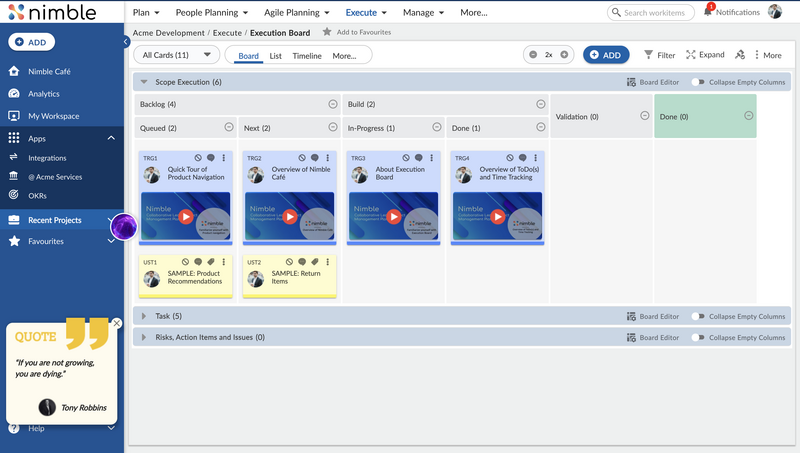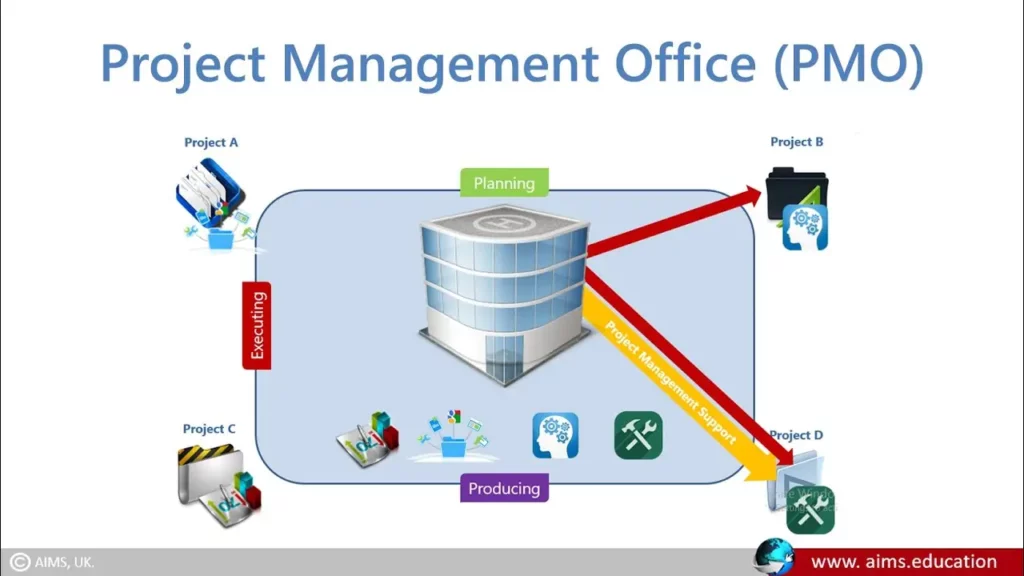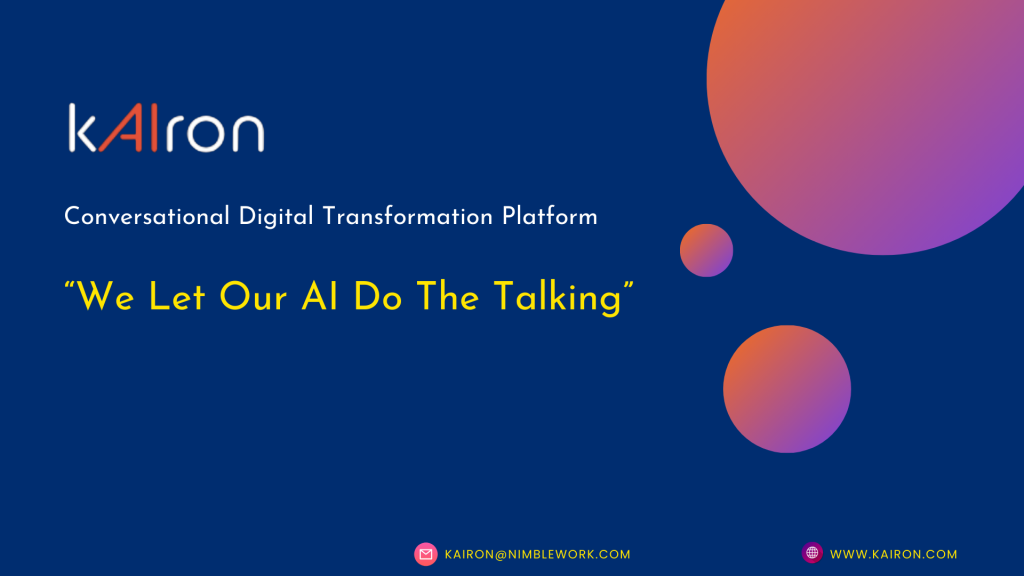What is a Project Management Office (PMO) - And What is It's Future?
- 15 mins read
-
By Simli Saha
- Updated on May 30, 2024
Overview
Introduction to Project Management Office (PMO)
As an organization grows, so do the amount and scale of its various projects. With the growing number of projects to undertake, it becomes increasingly difficult for the organization to craft a specialized strategy from the ground up for each specific project. With the arrival of the Project Economy, this has become more critical than ever.
To help ease the process of managing enterprise-wide projects, a set of rules and guidelines can be established to bring some level of standardization for all projects. This streamlines the work for project managers and their teams, making it easier for them to understand exactly what they need to do and by when they need to do them. At the same time, it provides stakeholders and customers a more organized way to evaluate projects, determine their progress and make ongoing funding decisions.
Who within the organization is best suited – and typically responsible – for creating and managing these standards? The Project Management Office.
What is a Project Management Office (PMO)?
A project management office, or PMO, is typically a team or a group that establishes, maintains, and oversees the implementation of project management standards across an organization. They are a centralized hub for all project management needs, such as documentation, strategy, and guidance.
The idea of the Project Management Office did not originate in business. According to the Project Management Institute, in the 1930s, the United States Air Corps created one of the first Project Office functions to monitor the development of their aircrafts and missile systems. It may not be the first reference to a project office, as there are some references dating back to the 1800s. In the case of the United States Air Corps, this function was actually composed of several sub-projects, called system program offices (SPOs), grouped together. They oversaw not only the development of the missiles, but also the warheads, support equipment, launchers, and even training and logistics support.
The key benefits of having a single program office were improved budget predictions, standardized planning, being able to identify unnecessary initiatives, and centralizing funding into packages rather than separate components.
In the 1980s, businesses started to see how the concept of a centralized office could be beneficial. The idea was adopted across multiple industries, including construction, IT, software development, and other sectors. This eventually led to what we now know as the Project Management Office.
Today, most organizations have implemented, or are starting to implement PMOs. According to a survey done by Business2Community, about 80% of high-performing organizations, otherwise known as industry champions, are using PMOs. The same survey also found that most enterprises, across all scales, are using PMOs as well.
Originally, the Project Management Office was an administrative body that was mainly responsible for the strategic planning of projects. However, the modern PMO has more roles aside from this.
What are the specific roles of the PMO?
Just like the U.S. Air Corps’ Project Office, the modern PMO tends to have a variety of roles and responsibilities with the ultimate goal of improving project management standards. However, it must be noted that the specific roles for a PMO can differ across different organizations. These various roles may include:
Strategic Planning
Originally, strategic planning was the main, sometimes only, role of the Project Management Office. As the architect of an organization’s projects, the PMO is responsible for analyzing an organization’s needs and setting goals based on these.
This role goes deeper than simply creating a blueprint of goals and projects as it is also tasked with prioritizing them so that the organization understands which milestone to work towards first. This is typically decided based on how much value the project can generate for the business, how achievable it is within a given time frame, as well as if it is aligned with the organization’s overall goals.
Resource Management
Traditionally, resource management is not part of the Project Management Office’s responsibilities. However, today the PMO may also be tasked with the budgeting of resources across the organization’s project slate. If given this responsibility, it can guide the organization on which and how much resources are allocated for each initiative.
The PMO does not handle resource management the same way a resource manager or project manager does. Instead, the PMO manages resources at a higher level, examining what resources the company currently has at its disposal and examining where they’re most needed. These resources are not just limited to budget, time, and tools, but also extends to skilled individuals and team members as well.
Project Governance
One of the major differences between early and modern PMOs is that the latter tend to be more actively involved in the execution phase of a project. Modern PMOs can provide valuable insight and guidance to project teams, even if not necessarily a part of them.
Modern PMOs can also choose to be more “hands-on” with their project teams, giving specific directions for them to follow. This can help ensure that the project runs smoothly, within the budget, is delivered in a timely manner, and produces the desired results–especially with newer, less experienced teams.
Project Tool Mobilization
For a project to be successful, its team must be equipped with everything necessary to succeed. One of the roles that a PMO may have in an organization is giving – or recommending to – the teams whatever they need for the overall success of the project. This can include templates, data charts, and software as well as any necessary training required to effectively utilize these tools.
Nimble revolutionizes project management, offering intuitive tools and streamlined processes to enhance collaboration, efficiency, and success.
Project Management Training
Poor training of project managers tends to result in project failure. According to Wellingtone’s The State of Project Management Report, one of the bigger challenges in Project Management is lackluster training and education of project managers.
While most organizations have PMOs, the most successful businesses utilize them to train project managers. PMSolutions’ report states that 85% of high-performing organizations have a project management training program in place. Thus training project managers in areas such as software tool use, project management basics, and leadership can lead to better overall project performance.
Additionally, the Project Management Office can also be tasked with documentation and archiving of projects. Not only does this help the PMO monitor project management trends over time, but these tasks can also help inform the PMO of the results of their training program allowing them to make specific adjustments. For example, if project managers have frequently expressed concerns regarding the chosen project management tool, this can cause the PMO to reassess their tool training process.
Who staffs the PMO?
Just like the responsibilities of the Project Management Office, there are no standardized titles across all PMOs. The titles may vary among organizations, but the roles and responsibilities of the people in the PMO remain largely the same. These roles tend to be:
PMO Director
Project and Program Managers
Traditionally, Project and Program Managers would not be included under the PMO. However, as more organizations have begun shifting the PMO to be a centralized hub for all the organization’s project management needs, this has started to change. In fact, according to PMSolutions, the most successful organizations are those with PMOs that also manage project managers and support roles.
Support Roles
PMOs often have support roles to help project managers with tasks such as gathering data, archiving results, documentation, and scheduling. Typically, only larger enterprises, with larger budgets, have the resources to staff dedicated support roles. Some examples of these roles are:
Project Schedulers
Project Controllers
Project Planners
Project planners are dedicated to planning and monitoring projects from beginning to end. Unlike project schedulers, project planners are tasked with monitoring more than just timelines, as they must track the progress of tasks and ensure that the projects are still within the budget as well.
Administrative Staff
PMO Trainers
PMO trainers, otherwise known as best practice or process experts, are in charge of providing project managers with the training they need to successfully complete projects for the organization. They are responsible for ensuring that the company’s project managers are trained to use software tools as well as equipped with soft skills such as leadership, problem-solving, decision-making, and effective communication.
What are the different types of PMO?
As PMOs vary in specific functions and names across different organizations, there are no concrete types of PMO. However, according to the Project Management Institute, PMOs can be categorized based on either their influence and position within their organization.
1. Different types of PMO (Influence)
Supportive
Supportive PMOs play a passive, consultative role in projects. This kind of PMO usually does very little after equipping project managers with the necessary templates, best practices, training, and resources. However, it tends to be available for consultations and clarifications should the project team ever need guidance.
As there would typically be a high level of trust between a Supportive PMO and their project teams, the degree of control provided by the PMO is low to non-existent.
Directive
Opposite from Supportive PMOs are Directive PMOs. Unlike the former, Directive PMOs have the highest level of influence on projects as it directly manages them and goes beyond simply providing tools, guidance, frameworks, and other means of support when solicited.
In some cases, this type of PMO can be beneficial, as it means that the centralized hub, with all of their data, analytics, and best practices, is in direct control of the project and potentially decreasing chances of project failure. As such, the degree of control provided by Directive PMOs is the highest.
A Directive PMO is not necessarily there due to a lack of trust between them and their project teams. For example, an organization in a highly-regulated industry, such as fintech or construction, may benefit from having its project teams report directly to the PMO.
Controlling
Controlling PMOs are the middle ground between Supportive and Directive PMOs. This type of PMO acts as an auditing body for projects, enforcing standards across the organization. It does this by providing frameworks and methodologies for people teams to follow, as well as checking in with project teams to ensure that they’re following the proper standards.
By design, a Controlling PMO is moderately involved in projects. This kind of PMO also has the right to intervene to correct mistakes that result in lowered performance, such as poor resource allocation and ineffective communication.
Traditionally, this type of PMO was the most common. However, as PMOs have shifted from being governing bodies to a more supportive role, this is no longer the case.
2. Different types of PMO (Position)
PMOs can also be categorized depending on their location within an organization’s hierarchy. The PMO’s position then decides which projects it supports. The different kinds of PMOs in this category are as follows:
Individual
Individual PMOs typically provide basic support (e.g. infrastructure, frameworks, templates, and training) to a single project or program. It is in charge of setting standards, goals, and objectives as well as supervising every stage of the project from start to finish.
Departmental
Departmental PMOs are responsible for projects providing support for projects within a single department. For example, an organization’s IT arm may have its own PMO–an IT PMO. The main advantage of having Departmental PMOs is that it helps build the capabilities of their specific department to deliver projects.
Enterprise
Sometimes called the Corporate PMO or abbreviated to EPMO, this type of PMO creates standards, processes, and methodologies to improve project performance across an entire organization. Unlike the other two types of PMO in this category, an EPMO provides a high-level view of the organization’s project portfolio, creating visibility across departments so that the organization can effectively coordinate strategic alignment of projects.
What are the benefits of having a PMO?
The benefits and the degree of these benefits can vary depending on the type of PMO that the organization has. Some examples of these benefits are:
Standardized processes and project management maturity
Even in a world where businesses are shifting to be more Agile, all organizations can benefit from some level of standardization as this can help begin new projects faster. The Project Management Office can provide templates and best practices to help project teams jumpstart their projects, allowing them to reach maturity faster.
However, these templates and best practices need not necessarily be treated as sacrosanct. Instead, they can serve as mere guidelines for project teams to follow and change depending on their needs.
Dedicated data analysis
By design, the Project Management Office is also tasked with extensive documentation and data analysis. Through these, the PMO can gather insights that can help the organization identify points of improvement in their processes and practices. For example, if project teams are regularly finding themselves missing deadlines, the PMO may have some insights pointing towards overly ambitious timelines or poor project manager training and make the necessary changes.
Additionally, PMOs can provide direction and support during the execution phase through sharing these insights. The degree of support that the PMO can provide varies depending on the type of PMO it is. See the previous section on the different types of PMOs for more information.
Having the PMO as a dedicated data analysis center to constantly update templates, best practices, and methodologies ensures that an organization is always growing and continues to stay relevant and competitive.
Centralized hub for education and training
The PMO can provide training for all project and program managers in an organization, as well as all the tools that they need, such as templates and software, to meet their goals. Having all of these resources available in a single centralized hub makes it easier for project teams to know where to go in case the need for them arises.
The PMO can also provide standardized training which ensures that all project managers in an organization are taught the same skills to a similar degree of proficiency. Having all project managers go through the same training process ensures that they will have a shared understanding of tools and processes, making it easier for them to stay on the same page.
Lower Costs, Increased Value
Having a Project Management Office actually helps organizations deliver projects under budget. In 2016, PMSolutions’ report interestingly stated that high-performing organizations with PMOs worked on an average of 85 projects per year. Compared to low-performers, who averaged 50 projects per year, it would make sense that they would need a larger budget. However, this is not the case as the high-performers actually had a lower average budget per project ($400k vs $500k) despite having more of them.
Even with a comparatively lower project budget on average, organizations with PMOs have a higher project success rate. The same report cited above states that higher performing organizations with PMOs experience a greater decrease of project failure than low performers (28% vs 17%). Additionally, PMOs simply help organizations increase their project success rate. According to the Project Management Institute, the success rate of projects at organizations with a PMO was 65% higher than those without one
Top PMO Challenges
The presence of a PMO in an organization does not guarantee success as there are many challenges that they may face. For a PMO to be effective, it must understand what these challenges are and, subsequently, how to overcome them. Here are the three main challenges that PMOs must face:
Scoping and estimation
Clear goals and accurate estimation of resources lay the foundation for an effective project execution. However, there are a number of issues that can arise during the conceptualization phase, mainly revolving around the scoping and estimation of the project.
As previously mentioned, the PMO may be tasked with setting goals for various projects. Every aspect of these goals, such as when specific milestones are due, has to be clearly defined and communicated to their respective teams. Otherwise, teams may feel lost due to the lack of direction and subsequently focus on the wrong targets.
The PMO also has to be realistic when estimating how much resources a project team needs. If a PMO were to set a budget or deadline that is too tight for a project team to effectively deliver given the constraints, they are dooming that project to fail from the very beginning.
Planning and problem monitoring
The execution phase of the project also has its own challenges. These tend to arise from ineffective, or unreasonable, plans developed during the planning phase.
One example is the PMO has to be aware of the potential risks that the project may face during the execution phase and devise strategies to manage them. Without proper contingencies in place, projects become more susceptible to delays, and eventual failure.
Internal team challenges
The PMO may also face interpersonal challenges between project team members. These problems tend to be directly within the control of, and sometimes due to, the project manager’s style, approach, and discipline of project management.
Project managers may or may not be directly under the PMO in some organizations. In businesses where this is not the case, there may be misalignment between the two that can turn into an “us versus them” dynamic.
One of the primary functions of the PMO is training and skills development of project managers. However, training can only be effective if project managers are willing to be trained. Thus it is essential that project managers buy-in to the idea of a PMO to minimize such challenges.
If you wish to see these challenges explored in further detail, as well as find out how to overcome them, you may do so by reading our article on the Top 3 Project Management Challenges.
Characteristics of a Modern, Agile PMO
Traditionally, the idea of a PMO would bring images of a bureaucratic, controlling governing body. While the ultimate goal of the PMO, to solve business problems and guide the organization toward a specific and positive outcome, has largely remained the same, how it achieves this goal has changed. While traditional, controlling PMOs still exist, the more modern kind of PMO, the Agile PMO, is much more flexible. Here are three characteristics of Agile PMOs:
Consultative, not Managerial
As one of Agile’s principles is self-organized teams, the PMO plays a supportive, consultative role rather than controlling, authoritarian one when in an Agile context. By playing the role of consultant rather than manager, the PMO empowers teams to make their own decisions, potentially removing any delays caused by time-consuming approval processes, while still providing guidance whenever sought out.
Agile PMOs also focus on providing visible and accessible data for teams to make their own informed decisions rather than forcing them to comply with previously set standards. Along with allowing every team member to take ownership and accountability for the project, Agile PMOs also reduce friction between project teams and their governing body.
Designed for Innovation
Modern business landscapes are always evolving due to disruptions such as new technologies. As such, the modern PMO must be adaptable and constantly work on innovating and updating its practices.
While the traditional PMO emphasizes a formal, rigid approach to project management, the modern PMO may find value in treating each project as a unique and complex entity.
Though templates and best practices provided by PMOs can be helpful to project teams, modern contexts demand for these to be used as guidelines that can be changed according to the needs of the team rather than stencils that must be followed to a tee. “Painting by the numbers” may yield expected results, but constantly relying on them, without innovating them, will lead to stagnation and lack of growth.
Optimized for Maximum Value
Today’s PMOs must ensure that they are maximizing the value that the organization delivers by focusing on delivering the right solutions at the most optimal times.
The Modern PMO understands that planning is no longer an exercise to be done at the start of the year, rather it is instead done continuously throughout the year. While the Traditional PMO asks for the progress towards goals set at the beginning of the year, the Modern PMO questions whether the goals are still what should be pursued, and changes them if this is no longer the case.
The Future of PMOs
Today’s best practices aren’t always going to be tomorrow’s. It’s hard to say exactly what the PMOs of the future will be like from where we stand today. However, as PMOs are trending to become supportive, consultative structures rather than the authoritative and controlling bodies that they originally were, it’s fair to say that the PMOs of the future will become even more supportive, more innovative, and more Agile.
One thing will be for certain: PMOs will always need effective tools to make managing work more efficient and easy. Nimble has a variety of built-in features useful for PMOs and project teams alike. If you are interested, you may request a demo here.
Share the Knowledge
About Author:
Simli Saha
Simplifying Project Management!
Explore Nimble! Take a FREE 30 Day Trial
PM 101
What is a Contingency Plan? 5 Steps to Create One
Learn what a contingency plan is and follow five key steps to create one for your project. Ensure your team is prepared to handle unexpected challenges and minimize risks.
What is a RACI Chart? A Complete Guide for Project Managers
Learn what a RACI chart is, how it clarifies roles and responsibilities in project management, and how to create one for your team to improve collaboration and accountability.
5 Best Templates for Product Development
Discover the 5 best templates for product development that streamline processes, enhance collaboration, and drive innovation. Optimize your product strategy with these top picks.
What Is a Statement of Work in Project Management?
A Statement of Work (SoW) is a formal document that comprehensively outlines the specifics of a project. It serves as a definitive guide, detailing the project’s objectives, deliverables, scope, timelines, and the roles and responsibilities of all parties involved.
What are Stakeholders? Definition, Types, and Importance in Business
Understand stakeholders in business: their roles, importance, and management strategies. Learn how to effectively engage stakeholders and use tools like Nimble to boost project success.
Discover what defines a project, its key characteristics, and lifecycle stages. Learn how effective project management drives organizational success and explore modern tools for streamlined project execution.
What Is Task Management? Strategies for Time Management, Organization, and Workflow Efficiency
Master task management strategies to boost productivity and efficiency. This guide covers planning, prioritization, time optimization, workflow streamlining, and overcoming procrastination for successful project delivery.
What is an Action Plan? A Guide to Creating Effective Project Goals – (With Examples)
Learn how to create and implement effective action plans to boost project management and personal productivity. Discover key components, practical uses, and best practices for achieving your goals.
Speed up your Agile planning and execution!
Signup for a FREE Trial of Nimble Agile






